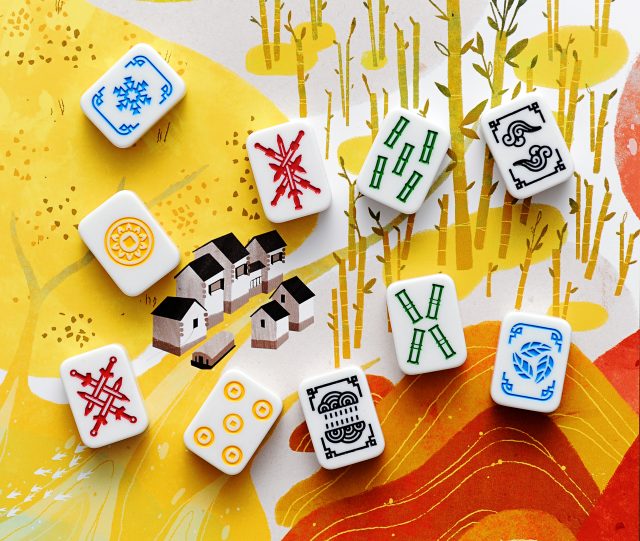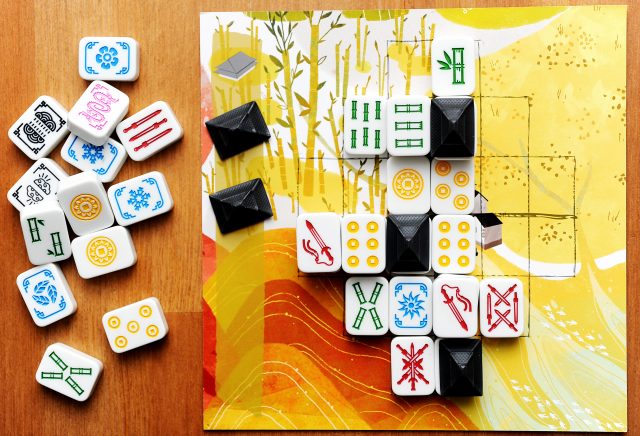After centuries of standing as a beacon to the all the people of the land and serving as the home of the Elder Dragon, the Dragon Castle has fallen into disrepair. It is beginning to crumble and soon there will be nothing left. But from the ruins, you have the opportunity to begin again. Taking stones from the old palace, you can build a new Dragon Castle. With smart moves and a little bit of luck, your construction will attract not only the people to your realm, but the Elder Dragon himself.
 Dragon Castle is the new game from CMON and Horrible games. It is heavily influenced by classic Mahjong, but since I’m not super familiar with that game, you’re just getting a straight review here.
Dragon Castle is the new game from CMON and Horrible games. It is heavily influenced by classic Mahjong, but since I’m not super familiar with that game, you’re just getting a straight review here.
The central strategy in the game surrounds 116 beautiful and chunky tiles. They come in three different Factions of Merchants, Soldiers, and Farmers, as well as three different types of Special Tiles of Seasons, Winds, and Dragons. The Factions are much more common than the Special Tiles, with the Dragons being the rarest of all. The Factions have different numbers of symbols within the same suit, the Special Tiles just have different symbols.
At the start of the game, the Dragon Castile is constructed in the central board using all 116 tiles. There is a standard set up with a single level on the outside, then a second tier, and a third in the centre. However, the rules include tons of different suggested setups to start the game, as well as allowing for you to come up with your own designs.
Players each have their own Realm boards and the goal is to take tiles from the declining Dragon Castle and construct your own worthy of the Elder Dragon, earning points along the way. They will start with one Shrine, but they can earn more throughout the game.
On a turn, player can take one of four different actions. They can take an available tile from the top level of the Dragon Castle and another available one from anywhere else in the Castle that matches it exactly. To be available, a tile must be open along one of its long sides. The pair of tiles is added to your Realm board face up wherever you want. Tiles must be either placed on open spaces or on other facedown tiles. The Second action is to take one available tile from the top row and a Shrine from the  pool. The next possible move is simply discarding an available tile and taking a point (a perfect move when you’re looking to deny an opponent a tile they really want…y’know, like a jerk). The final move you can do when only the lowest level of the Dragon Castle is left. You can Summon the Dragon by taking one of the Countdown tokens. They’re worth two points each, but they also work as a timer for the game. A certain number of Countdown tokens are put out on a track on the Central board depending on the number of players. Once enough Countdown tokens are taken, game end is triggered, with the players finishing out the current round.
pool. The next possible move is simply discarding an available tile and taking a point (a perfect move when you’re looking to deny an opponent a tile they really want…y’know, like a jerk). The final move you can do when only the lowest level of the Dragon Castle is left. You can Summon the Dragon by taking one of the Countdown tokens. They’re worth two points each, but they also work as a timer for the game. A certain number of Countdown tokens are put out on a track on the Central board depending on the number of players. Once enough Countdown tokens are taken, game end is triggered, with the players finishing out the current round.
As you’re collecting tiles throughout the game, you add them to your Realm board and start constructing your own rival palace. When you add tiles to your Realm you’re looking to collect sets together. The bigger the set you create the more points it’s worth. However, as soon as there are four tiles of the same suit touching, you must consolidate them. Consolidating tiles means flipping them over and scoring points for the grouping. You will also have the opportunity to add one or more Shrines depending on the suit you consolidated. Flipping a grouping of four tiles will earn you a measly two points, and you’re not impressing any Elder Dragons that way. Groups of five will earn three points, six will earn five, groups of eight will earn eight points and each additional tile will earn an additional point. You have to decide when is the right time to push a little further for a bigger group, and when it’s wiser to cash in on the set you already have.
 When you consolidate tiles, you have the option of placing Shrines. Consolidated Factions allow you to place one Shrine, Special tiles allow you to place two, and Dragons allow you to place two and you earn a bonus point. The benefit of Shrines is that they’ll earn you end game points. The drawback is that you can’t place any more tiles in a space you’re placed a Shrine (anyone who’s ever built a Dragon Castle will confirm that). At the end of the game, Shrines earn points equal to the level they’re on.
When you consolidate tiles, you have the option of placing Shrines. Consolidated Factions allow you to place one Shrine, Special tiles allow you to place two, and Dragons allow you to place two and you earn a bonus point. The benefit of Shrines is that they’ll earn you end game points. The drawback is that you can’t place any more tiles in a space you’re placed a Shrine (anyone who’s ever built a Dragon Castle will confirm that). At the end of the game, Shrines earn points equal to the level they’re on.
Speaking of the end of the game, once everyone has taken a final turn, player count up the point tokens they’ve earned and add points for Shrines and Countdown tokens. The person with the most points is the winner!
Those are the rules for the basic game of Dragon Castle. Once you feel like you have the hang of the game, you can add in Spirit and Dragon cards. The Spirit cards allow you to perform special actions by discarding a face up tile or Shrine. These abilities allow you to do things like consolidate tiles of the same number rather than the same suit, or take tiles you wouldn’t normally be able to take. They’re not game changing, but they can be very helpful under the right circumstances.
 The Dragon cards give you extra goals to shoot for in the game, like getting extra points for building Shrines in a certain way, or constructing non-adjacent stacks of tiles in your castle. The Dragon cards make you think on a slightly different level about the way you’re placing your tiles. I really enjoy the added level of depth they provide.
The Dragon cards give you extra goals to shoot for in the game, like getting extra points for building Shrines in a certain way, or constructing non-adjacent stacks of tiles in your castle. The Dragon cards make you think on a slightly different level about the way you’re placing your tiles. I really enjoy the added level of depth they provide.
Dragon Castle is an extremely satisfying and highly replayable experience. There isn’t a ton of player interaction, except when you toss away that tile your opponent so desperately needed, but it feels great to work on building your own castle. When you find the pair that you need or consolidate a big group, you start to think you might be the world’s greatest architect, one worthy of the respect, maybe even love of the Elder Dragon. Definitely check this one out if you get the chance!
Nit-pick: This is based on the non-classic computer game Mahjong, which uses the same tiles as the classic Chinese game but has entirely different gameplay. (Original Mahjong is like the card game Rummy, with tiles instead of cards.)
Awesome! Thanks for the clarification.